
About 7,0 GB of storage will be hijacked by the new Windows 10!

The next version of Windows 10 (19H1) will redesign our storage a bit.

According to the latest news, the next release of the operating system will already include the development that the software will create a spare storage area; its size will be around 7,0 GB. Windows 10 will download the current updates here and then install it from here. Microsoft did all this because there are still a large number of computers (primarily laptops) that cannot be installed with a security patch because they simply do not have enough space. By definition, this method will not increase the storage space, but at the same time guarantees that there is enough storage capacity for the update packages. To put it even more simply, Windows thus rules out the possibility of filling the partition with the user's personal files so much that there are already problems installing updates there.

The "fenced" space can also be used by Windows to store temporary files, which will be automatically deleted during the upgrade. In theory, this means that we will not lose anything of the available storage, but in practice, it is likely that there will be users who do not have 7,0 GB of temporary files, so there will still be unused space. The exact size of the repository otherwise depends on the individual environment (services, language packs, etc.), if the base system is larger, then obviously this partition will also be larger. The solution may be to include the system in the diet, as this will also affect this partition.
Windows 10 19H1 (1903) is likely to be released in April. The novelty takes effect automatically when upgrading or during a clean installation. It is not possible to remove storage space, but its size may change in the future (for example, based on diagnostic data, possibly due to user feedback).














